CHEMISTRY-LABORATORY TECHNIQUES AND SAFETY
A laboratory is a room or building specially designed for conducting various scientific experiments. An appropriate school laboratory has the following features:
- a room with enough space for carrying out scientific experiments;
- a store for keeping laboratory apparatus, chemicals and reagents;
- an office for laboratory technician to sit in and design scientific experiments;
- enough ventilation to let in fresh air and light;
- wide doors and several exits for emergency evacuation in case of an accident; and
- a wide table in front of the laboratory room, fitted with sinks for experiment demonstrations by the teacher or technician.
Rules and safety precautions in a chemistry laboratory
First aid and first aid kit
FIRST AID
First aid is the help given to someone who is injured or sick before the victim gets further medical assistance. This help can be given by any person regardless of his/her knowledge in a medical profession.
Whenever an accident occurs, something must be done immediately to help and save life of the victim. You must always be ready to give a hand to a victim whenever an accident occurs close to you. To give aid effectively and successfully, one must have elementary knowledge on how to assist different victims. If you do not know how to help a certain victim, you can ask someone to assist instead. Do not engage yourself in assisting if you actually do not know where to start. You may find yourself worsening the situation of the victim unknowingly. However, this should not be taken as an excuse for failing to help. Always be ready to render some kind of help. First aid helps to:
- relieve pain and bring hope to the victim.
- prevent permanent disability
- prevent the victim’s condition from getting worse
- reduce the possibility of death.
- shorten recovery time
Possible Causes of Accidents in a Chemistry Laboratory
Identify possible causes of accidents in a chemistry laboratory
Accidents may occur in a school laboratory if utmost care is not taken into account. Accidents in the laboratory are mainly cuts on parts of the body such as hands, fingers, legs or head. Others are burns from flames, scalds from boiling fluids, bruises and grazes due to accidental falling on a slippery floor.
Some possible causes of accidents in the laboratory include:
- Failure to follow the correct experimental procedures for example, pouring water into an acid instead of pouring an acid into water as the rule is.
- Neglecting some laboratories rules such as ignoring to wear protective gears, tasting the chemicals, eating or drinking while in the laboratory, etc.
- Failure to adhere to proper conduct in the laboratory like running unnecessarily and conducting experiments without your teacher's or technician's permission and guidance.
- Improper use or handling of laboratory equipment and apparatus when conducting experiments, which could lead to breakage and in turn cause cuts, bruises, grazes, etc.
- A slippery laboratory floor which can cause fractures, cuts, bruises, grazes, etc
- Accidental spillage of chemicals on body parts such as hands, face, eyes, etc, could lead to burns and damage.
- Poor ventilation in the laboratory may cause suffocation (due to inadequate oxygen supply) and poisoning (by inhaling poisonous gases produced when experimenting).
- Improper disposal of chemical wastes may result in explosions, burns or even fires.
- The leaking of gases from taps or cylinders may cause fires or even explosions.
- Use of wrong reagents due to incorrect labeling of chemicals or use of reagents or chemicals that have expired may cause burns, poisoning or damage to apparatus or equipment.
- Inadequate prior information or knowledge on procedures and hazards associated with certain practical activities or reactants may result in burns, poisoning or explosions.
- Loose or improperly plugged electrical appliances may cause electric shock, especially when touched with wet hands and during fixing of sockets.
In general, it can be concluded that most laboratory accidents are a result of negligence and carelessness of experimenters. It is also due to failure to follow the laboratory rules and general safety measures.
The Items Found in a First Aid Kit
Name the items found in a first aid kit
A First Aid Kit is a box in which first aid chemicals, tools and instruments are kept. In the laboratory, the box is usually kept in a place where it can be easily reached in case of an accident, preferably on the wall.
Each student must be familiar with the tools and chemicals kept in the kit and learn how to use them to provide first aid to a victim.

First aid kit and its contents
How Each First Aid Kit Item is Used
Demonstrate how each first aid kit item is used
The table below shows types of chemicals found in a First Aid Kit and their functions.
| Tool/chemical/item | Function |
| First aid manual | Contains guidelines on how to use the items in the first aid kit |
| Sterile gloves | Worn on hands when attending bleeding cuts or wounds to avoid infecting wounds and to prevent direct contact with the victim’s body fluids |
| Sterile dressing | Stops bleeding |
| Antiseptic agent | Cleaning and disinfection of wounds, cuts, bruises, grazes or blisters |
| Soap | Washing hands, wounds and equipment |
| Antibiotic ointment | Prevents infection on cuts and bruises in or near the eye |
| Burn ointment | Applied on burns to prevent infection |
| Petroleum jelly | Soothing broken skin |
| Plaster or adhesive bandage | Covering small wounds or cuts |
| Sterile gauze | Covering wounds to protect them from dirt or germs |
| Eye wash solution | Flushing the eyes or as a general decontaminant |
| Thermometer | Recording body temperature |
| Antibiotic towelettes or cotton wool | Cleaning and drying cuts and wounds |
| Iodine tincture | Dressing fresh cuts and bruises |
| Pain relieving drugs such as aspirin, paracetamol, panadol, etc | Relieving mild pains |
| Liniment | Reducing muscle pain |
| Mild antibiotics | Treating mild bacterial infections on the skin, ear, nose and mouth |
| Gentian violet solution | Applied on minor wounds and treatment of serious heat wounds |
| Hydrogen peroxide solution | Cleaning wounds |
| Methylated spirit (70% alcohol) | Cleaning cuts and bruises |
| Bandages | Dressing wounds and cuts, and immobilizing injured limbs |
| Scissors or razor blade | Cutting dressing materials |
| Dental kit | Treatment of broken teeth, loss of crown or filling |
| Safety pins (small and big) | Splinter removal and securing triangular bandage slings |
| Tweezers | Splinter or stinger removal |
| Resealable oven bag | Container for contaminated articles |
| Moleskin | Applied to blisters or hot spots |
| Triangular bandage | Used as a sling, towel or tourniquet |
| Boiled, clean water | Washing hands and drinking |
| Nasal spray decongestant | Nasal congestion from colds or allergies |
| Torch | Source of light |
| Whistle | Blown to call for help |
The Items in a First Aid kit to Provide First Aid to an Accident Victim
Use the items in a first aid kit to provide first aid to an accident victim
First aid procedures
Sometimes accidents may occur in the laboratory due to some reasons or the other. Whenever an accident occurs, one must be ready and prepared to assist. The following are some of the health problems that may require first aid and the procedure to follow when providing help.
Bleeding
Bleeding is the loss of blood from the body and usually occurs from a visible wound. Bleeding may be external or internal. It may from artery, vein or capillary. Bleeding may be severe or light. Excessive loss of blood may cause death.
(a) Internal bleeding
Signs and symptoms of internal bleeding include the following:
- Bruised, swollen, tender or rigid abdomen
- Bruises on chest, neck, legs or signs of fractured ribs
- Vomiting or coughing up blood.
- Wounds that have penetrated the skull, chest or abdomen
- Bleeding from body cavities such as the ears, nose, rectum or vagina
- Abdominal pulse and difficulty breathing
- Cool, moist skin
- Fractures
Procedure
- First aid in the field for internal bleeding is limited. If the injury appears to be a simple bruise, apply cold packs to slow down the bleeding, relieve pain and reduce swelling.
- If you suspect more severe internal bleeding, carefully monitor the patient. Be prepared to administer CPR if required (and you are trained to do so).
- Seek medical advice immediately if the situation seems to be worse.
(b) Severe bleeding
Procedure
- Severe bleeding with blood oozing out rapidly must be stopped at once. This can be done by applying direct pressure to the wound. Use a dressing if available. If it is not available, use a rag, towel, piece of clothing or your fingers alone. If the wound is large, press the edges of the wound together but firmly. However, this should be done only if there is no fracture.
- Lay the victim down in a comfortable position.
- If the wound is on a limb, and provided it is not fractured, raise the wound above the level of the heart. Then continue to apply direct pressure. This should be done only if bleeding continues and if it does not cause pain.
- If bleeding still cannot be controlled, the next step is to apply pressure at a pressure point. For wounds of the arms or hands, pressure points are located on the inside of the wrist (radial artery-where a pulse is checked) or on the inside of the upper arm (brachial artery). For wounds of the legs, the pressure point is at the crease in the groin (femoral artery).
- When bleeding stops, clean the wound carefully and thoroughly with a suitable disinfectant. Do not remove any objects stuck in the wound, as this would lead to more bleeding.
- Place sterile gauze on the wound and press it down firmly. Cover it with a soft material and hold it in position using a firm bandage. After the bandage is in place, it is important to check the pulse to make sure blood circulation is not interrupted. A slow pulse rate, or bluish fingertips or toes signal a bandage may be hindering blood circulation.
- Seek medical help immediately.
Important: Once pressure is applied, keep it in place. If dressings become soaked with blood, apply new dressings over the old dressings. The less a bleeding wound is disturbed, the easier it will be to stop the bleeding.
(c) Light bleeding
Procedure
- Place the victim in a comfortable resting position.
- Elevate the injured part while applying pressure. This should be done only if the wound is on a limb and you do not suspect a fracture.
- Gently and thoroughly clean the wound using water and antiseptic or common salt solution.
- Cover the wound with sterile gauze or clean dressing dipped in iodine solution.
- Dress and bandage the wound
- Take the victim to hospital if bleeding still continues.
(d) Nose bleeding
Bleeding usually occurs near the tip of the nose. The bleeding may be a result of high blood pressure, rheumatic fever, or injury. Nose bleeding is also likely to occur at high altitude because of low atmospheric pressure or extreme coldness.
nose-bleeding victim

Procedure
- Let the victim sit calmly. This makes the heartbeat to slow down and hence reduce bleeding.
- Loosen clothing around the neck and chest.
- Let the victim sit upright and lean the head forward slightly. By remaining upright, the victim reduces the blood pressure in the veins of his or her nose. This discourages further bleeding. Leaning forward will help the victim avoid swallowing blood, which can irritate his or her stomach.
- Have the victim pinch his or her nose, to keep nostrils shut, using thumb and index finger. Ask the victim to breath through the mouth. Let him or her continue pinching for a few minutes.
- Apply cold, wet compression over the nose, face and at the back of the victim’s neck.
- When bleeding stops, gently clean the nostrils.
- If bleeding does not stop after 20 minutes, take the victim to the hospital immediately.
- To prevent re-bleeding after bleeding has stopped:
- Ask the victim not to pick or blow the nose and not to bend down until several hours after bleeding.
- Let the victim keep his/her head higher than the level of his/her heart.
- If re-bleeding occurs:
- Ask the victim to blow out forcefully to clear the nose of blood clots. Spray both sides of the nose with decongestant nasal spray.
- Pinch the nose as described above and seek medical help.
nose-bleeding victim with his head leaned forward.
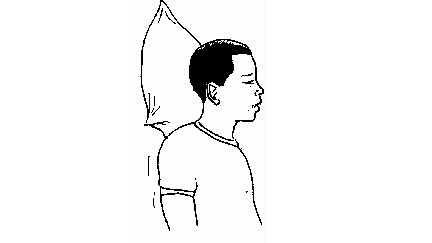
Suffocation
Suffocation is a condition in which the lungs are not getting enough oxygen, causing difficulty in breathing. In such cases, foams can also appear in the mouth and nostrils. If suffocation is complete (no air at all reaches the lungs), the lack of oxygen and excess carbon dioxide in the blood will cause immediate loss of consciousness. Though the heart continues to beat briefly, death will follow in a matter of minutes unless emergency measures are taken to get breathing started.
Suffocation can be caused by drowning, electric shock, gas or smoke poisoning, choking, asthma, severe infections of the throat or other causes.
Procedure
- Remove the cause of suffocation or remove the victim from the cause of suffocation. Loosen tight clothing around the neck.
- Make sure the victim’s airway is open for air to reach the lungs. This can be achieved by laying the victim on his or her back. Then, with one hand on the victim’s forehead and the other on the chin, tilt the head backwards, to open the airway. Tilt the head until the chin points straight upwards. If the airway is blocked by fluid or solid, remove it.
- Administer cardiopulmonary resuscitation (CPR). This involves blowing air into the victim’s mouth (mouth-to-mouth breathing). To do this, pinch the nose and close up the mouth. Take a deep breath and then blow hard into the victim’s mouth. Watch the rise in chest and repeat the procedure until the victim’s breathing is restored. In case the person does not respond, go for chest compressions.
- Compressions can be done by placing the palm of one hand in the space between the nipples and the other hand over it and pushing the chest by using your upper body weight. Care should be taken to prevent chest injury or fracture. Two compressions can be given every second or hundred per minute. After thirty compressions, go for mouth breathing again. Repeat the procedure until natural breathing is restored.
- Keep the casualty warm using a light blanket.
- Take the casualty to the hospital immediately.
figure.
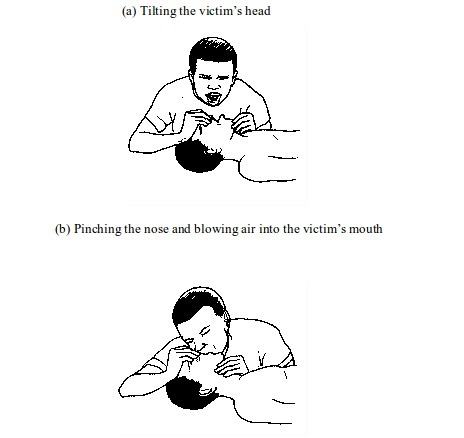
Choking
Choking occurs when food or a foreign object blocks the upper part of the windpipe. This interferes with normal breathing. The signs of this problem include difficulty in breathing and speaking. Have you ever been with a person who is chocking? Did you know what to do?
When attending a person who is chocking, first notice whether the person can talk, breathe or cough. Caution: Do not try to slap the person on the back. The slapping may only cause the food to become more deeply lodged in the airway.
Procedure
- Ask the victim to cough up the object.
- If the object remains stuck, give firm but gentle taps between the shoulder plates.
- If the object is still stuck, apply quick abdominal thrusts i.e. Heimlich manoeuvre as follows:
- Stand behind the victim and make him or her lean forward slightly.
- Put your arms around the person, placing your fist just below the breastbone. Grasp your fist with the other hand near the top of the victim’s stomach.
- Press your fist onto the victim’s abdomen. Give a series of quick, sharp upward and inward thrusts to dislodge the object.
Thrusting to dislodge the object

Poisoning
A poison is any substance that can harm the body or seriously endanger health when taken into the body. A poison may get into the body through inhaling, swallowing, wounds or skin cuts or absorbed into the body in other ways. Potential poisons include poisonous fumes (or gases), laboratory chemicals or even medical drugs and medicines.
In every household, there are different kinds of things that are poisonous. Some are deadly even on a very small dose. Others may be more or less harmless when taken in small quantities.
Examples of poisonous substances at home are kerosene, disinfectants, paints, medicines, artificial fertilizers, etc.
Some signs and symptoms of poisoning are nausea, vomiting, abdominal cramps, pain, difficulty breathing, diarrhea, and abnormal skin colour. Others are breath that smells like the chemicals, chemical burns, empty medication bottles or scattered pills, sleepiness, confusion or other unexpected signs.
Procedure
- Call for medical help immediately if the person shows one or some of the following signs: drowsy or unconscious; having difficulty breathing or has stopped breathing; uncontrollably restless or agitated.
- For the time being, find out what caused the poisoning, i.e. look for the poison and identify it.
- If the person has been exposed to poisonous fumes such as carbon monoxide, get him or her to where there is fresh air immediately.
- If the poison is in the eye:
- Wash the eye with a lot of clean water.
- Ask the victim to blink as much as possible.
- Do not rub the eye.
- If the person swallowed the poison:
- Remove anything remaining in the mouth
- Induce vomiting if the poison is not strong acid or alkali as these are corrosive substances. Non- corrosive substances include medicines and soaps. Vomiting can be induced by inserting your finger in the victim’s throat until the finger touches the epiglottis.
- Do not induce vomiting if the poison swallowed is corrosive. Corrosive substances include kerosene, bleach, detergent, laboratory acid, disinfectant or certain toiletries. If the suspected poison is a household cleaner or other chemical, read the label and follow instructions for handling accidental poisoning.
- Neutralize the poison by giving the victim plenty of milk to drink, an egg white or water.
- If the poison is on the skin:
- Remove any clothing from the affected part.
- Wash the affected area thoroughly with a lot of water.
- Do not apply any ointment.
- Make sure the person is breathing. If not, start rescue breathing and CPR.
Note: Take the poison container or any pills, pill bottle or pill blister pack with you to the hospital.
Shock
Shock is a condition in which the body system fails to take enough blood to the vital organs. If untreated, it can lead to permanent organ damage or death. The vital organs include the heart, the lungs, the brain, the kidneys and the liver.
Causes
Shock may result from bad news, heatstroke, severe illness, blood loss, dehydration, poisoning, severe burns, an accident or other causes.
Signs and symptoms
Various signs and symptoms appear in a person experiencing shock. They include the following:
- The skin becomes cool and moist. The skin, lips and fingernails may appear pale or grey.
- The pulse rate is weak and rapid. Breathing may be slow and shallow.
- The limbs may tremble and get weak.
- The eyes lack lustre and may seem to stare. Sometimes the pupils are dilated.
- As the shock develops, the victim may experience nausea and even vomiting. Eventually he or she may become restless, nervous, aggressive and finally conscious or unconscious. If conscious, the person may feel faint or be very weak or confused.
Procedure
- Control any cause of shock such as bleeding, etc.
- Lay the person down with his or her feet higher than his or her head (shock position).
- Loosen tight clothing, laces, belts and shoes.
- Turn the person on his or her side to prevent choking if the person vomits or bleeds from the mouth.
- Keep the person warm and comfortable if he/she feels cold. Cover the victim with a blanket or any heavy clothing.
- Seek treatment for injuries such as bleeding or broken bones.
- Administer CPR if the person does not appear to breath well, cough or even move.
- Seek medical help immediately.
The shock position
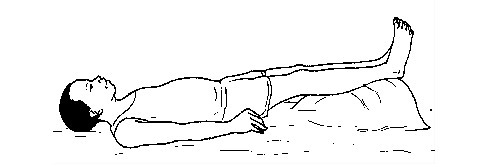
Electric shock
An electric shock occurs when a person comes into direct contact with electricity. Exposure to electricity may result in injury or even death. Injuries may be burns, or physical injuries that result from being thrown by the electric current.
Procedure
- Switch off the main switch immediately if possible.
- If not possible to put off the switch, detach the casualty from the source of electricity using a non-conducting object such as a dry wooden stick, cardboard, plastic or rope.
- Loosen any tight clothing, necklaces, bangles, etc.
- If the person is unconscious, apply mouth-to-mouth respiration (CPR) immediately.
- Treat for shock, burns, bruises or other injuries the victim may have sustained. Lay the victim down, and if possible, position the head slightly lower than the trunk, with the legs elevated (shock position).
- Take the person to the hospital immediately.
Caution
- Do not touch the person with your bare hands if he or she is still in contact with the electric current.
- Do not get near high-voltage electricity until power is turned off. Instead, call for help immediately.
- Do not move a person with an electrical injury unless the person is in immediate danger.
Bruises
A bruise is an injury beneath the skin. Bruises can be identified by pain, swelling or a mark under the skin. A bruise forms when a blow (hard hit) breaks the blood vessels near the skin’s surface. This allows a small amount of blood to leak into the tissues under the skin. The trapped blood appears as a blue-black mark.
Procedure
- Wash the bruised part of the body.
- Apply a cold compress, such as a cloth dipped in cold water or ice wrapped in a cloth, to the injury. This helps reduce pain, swelling, and speeds up recovery.
- If the bruise is on a limb such as arm or leg and it covers a large area, keep the limb elevated as much as possible for the past 24 hours.
- After 48 hours, apply a cloth dipped in tepid water to the bruise for about 10 minutes, three times a day. This will help increase blood flow to the affected area and thus speed up healing.
Bruises under the skin
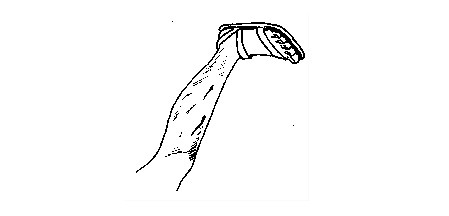
Vomiting
Vomiting is an involuntary ejection of the contents of the stomach through the mouth.
Possible causes of vomiting
- Allergic reactions
- Diseases e.g. malaria
- Physiological condition e.g. pregnancy
- Food poisoning
- Unpleasant smell or taste
- Drinking contaminated water.
- Inhaling poisonous fumes
- Over-eating.
Procedure
- Give the victim an oral rehydration drink or oral rehydration salt solution. You may also provide a lot of any clear fluids.
- Allow the person to have a complete rest.
- Take the victim to hospital if:
- Vomiting continues persistently.
- The victim vomits blood.
- The victim experiences high fever.
- The victim is very dehydrated. This will be observed when the mouth and skin become very dry.
A victim vomiting
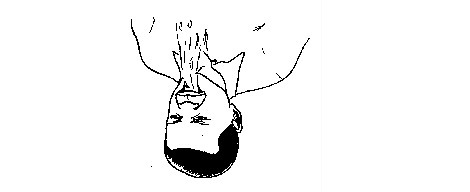
Fainting
Fainting is a sudden loss of consciousness caused by a temporary fall in the supply of blood and oxygen to the brain. Sometimes it can be caused by emotional shock or prolonged standing. The person feels weak, sweats and then falls down.
Procedure
- Loosen or remove any tight clothing from the victim.
- Make the victim lie down on his or her back.
- Raise the legs of the victim (shock position) above the level of his or her head. This will increase the flow of blood to the brain.
- Make sure the victim is exposed to plentiful supply of fresh air.
- If there is no improvement in a few minutes, rush the victim to the hospital
Caution: Do not try to warm the victim
Muscle cramps
A muscle cramp is an involuntarily and forcibly contracted muscle that does not relax. A muscle that contracts involuntarily is called a ‘’spasm.’’ If the spasm is forceful, it becomes a cramp. Therefore, muscle cramps occur because of uncontrolled muscle spasms.
Signs and symptoms
- A sharp, sudden and painful spasm, or tightening of a muscle (especially common in the legs).
- Muscle hardness
- Twitching of the muscle
- Persistent cramping pains in the lower abdominal muscles.
Causes
- Imbalance in certain minerals, body fluids, hormones, and chemicals that allow stretching and contracting of our muscles.
- Malfunctioning in the nervous system.
- Excessive physical activity and hormonal imbalances cause us to sweat. This brings about the loss of many essential minerals, such as potassium and calcium, which our body muscles need.
Procedure
- Lay the victim down
- Gently massage and stretch out the cramped muscle(s).
- Apply some anti-cramp ointment to the affected area
- If the problem persists, seek medical help immediately.
Stretching and massaging the muscles
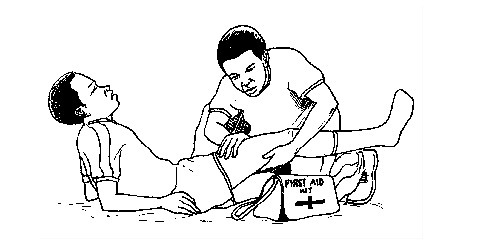
Hiccups
Hiccups are caused by sudden involuntary contraction of the diaphragm muscles, giving a characteristic ‘’hic’’ sound. Numerous cures for hiccups exist. These cures are thought to work because they increase the level of carbon dioxide in the blood, which usually stops hiccups. (See procedure 1-3 below). If the vagus nerve that runs from the brain to the stomach is stimulated, hiccups can also be alleviated.
Procedure
- Give the affected person a polythene bag and encourage him/her to re-breath her own expelled air.
- Ask the person to drink a glass of cold water quickly.
- Tell the victim to hold his/her breath for as long as possible.
- Ask the victim to pull on his/her tongue.
- The victim may swallow finely crushed ice.
- Children can be given a teaspoonful of a weak solution of sodium bicarbonate or lemon juice.
- Place one teaspoonful of dry sugar or honey on the back of the victim’s tongue. (You can repeat this process 3 times at 2-minute intervals)






